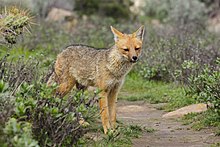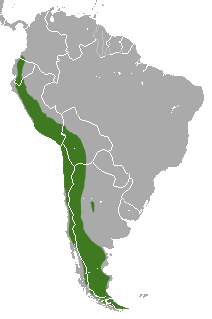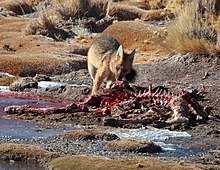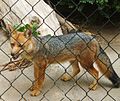
Tierra del Fuego is an archipelago off the southernmost tip of the South American mainland, across the Strait of Magellan.

Dusicyon is an extinct genus of South American canids.

The guanaco is a camelid native to South America, closely related to the llama. Guanacos are one of two wild South American camelids; the other species is the vicuña, which lives at higher elevations.

The South American foxes (Lycalopex), commonly called raposa in Portuguese, or zorro in Spanish, are a genus from South America of the subfamily Caninae. Despite their name, they are not true foxes, but are a unique canid genus more closely related to wolves and jackals than to true foxes; some of them resemble foxes due to convergent evolution. The South American gray fox, Lycalopex griseus, is the most common species, and is known for its large ears and a highly marketable, russet-fringed pelt.

Darwin's fox or Darwin's zorro is an endangered canid from the genus Lycalopex. It is also known as the zorro chilote or zorro de Darwin in Spanish and lives on Nahuelbuta National Park, the Cordillera de Oncol, Cordillera Pelada in mainland Chile and Chiloé Island. This small, dark canine weighs 1.8 to 3.95 kg, has a head-and-body length of 48 to 59 cm and a tail that is 17.5 to 25.5 cm. Darwin's fox displays no key differences between male and female other than the fact that the male has a broader muzzle. Males display no territorial behavior and are not aggressive towards other males roaming around their territory.

The Sechuran fox, also called the Peruvian desert fox or the Sechuran zorro, is a small South American species of canid closely related to other South American "false" foxes or zorro. It gets its name for being found in the Sechura Desert in northwestern Peru.

The Pampas fox, also known as grey pampean fox, Pampas zorro, Azara's fox, or Azara's zorro, is a medium-sized zorro, or "false" fox, native to the South American Pampas. Azara in some of its alternative common names is a reference to Spanish naturalist Félix de Azara.

The hoary fox or hoary zorro, also known as raposinha-do-campo in Brazil, is a species of zorro or "false" fox endemic to Brazil. Unlike many other foxes, it feeds primarily on small invertebrates such as insects.

The South American gray fox, also known as the Patagonian fox, the chilla or the gray zorro, is a species of Lycalopex, the "false" foxes. It is endemic to the southern part of South America.
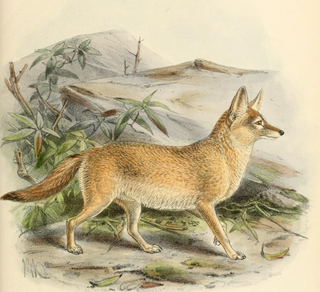
The pale fox is a species of fox found in the band of African Sahel from Senegal in the west to Sudan in the east. It is one of the least studied of all canid species, in part due to its remote habitat and its sandy coat that blends in well with the desert-like terrain.

Alberto de Agostini National Park is a protected area that was created on January 22, 1965, on land that was formerly part of the "Hollanda" forest reserve and "Hernando de Magallanes National Park". It covers 1,460,000 hectares and includes the Cordillera Darwin mountain range, which is the final land-based stretch of the Andes before it becomes a chain of mountains appearing as small islands that sink into the Pacific Ocean and the Beagle Channel.

Huerquehue National Park is located in the foothills of the Andes, in the Valdivian temperate rainforest of the La Araucanía region in southern Chile. It lies 145 km southeast of Temuco and 33 km east of Pucón, between the Villarrica National Reserve to the west and the Hualalafquén National Reserve to the east. The park encompasses 125 square kilometres of mountainous terrain east of Caburgua Lake, and has an elevation range of 720 to 2,000 m asl.
The Andean wolf is a purported South American canine that is falsely labelled a wolf. Various tests on the singular pelt have failed to provide a conclusive identity.

The Reserva Provincial La Payunia also known as Payún or Payén is a natural reserve located in the Malargüe Department in the southern part of Mendoza Province, Argentina, about 160 km away from Malargüe city. It was declared as nature preserve in 1988 and has an area of 4,500 km2. La Payunia is home to the many volcanic cones, being noteworthy the Payún Matrú volcano.

The northern viscacha is a species of viscacha, a rodent in the family Chinchillidae. It is known from Peru and Chile, at elevations from 300 to 5000 m, and may also be present in Bolivia.

San Guillermo National Park is a national park in Argentina, in the Iglesia Department of San Juan Province. It was established in 1998 and is part of the San Guillermo Biosphere Reserve. Elevations in the biosphere range from 2,100 metres (6,900 ft) to 6,380 metres (20,930 ft). Vegetation in the National Park and biosphere consists of barren desert, grasslands, and a few wetlands, all located in the high, arid Andes. The animals include vicuña, guanaco, culpeo fox, Andean mountain cat, cougar, and Andean condor.

Dusicyon avus is an extinct species of cerdocyonine canid in the genus Dusicyon, native to South America during the Pleistocene and Holocene epochs. It was medium to large, about the size of a German shepherd. It was closely related to the Falkland Islands wolf or warrah (Dusicyon australis), which descended from a population of D. avus. It appears to have survived until very recently, perhaps 400 years ago.

The Fuegian dog, or Yahgan dog, or Patagonian dog, is an extinct type of canid. In comparison to the domestic dog's ancient wolf ancestry, the Fuegian dog was traditionally thought to be bred and domesticated from the South American culpeo, also known as the culpeo fox. However, 2023 research suggested that the traditional accounts of the Fuegian dog were in fact two different animals. The culpeo itself is similar to true foxes, though it is closer, genetically, to wolves, coyotes and jackals ; thus it is placed in a separate genus within the South American foxes or zorros.

The Patagonian grasslands (NT0804) is an ecoregion in the south of Argentina and Chile. The grasslands are home to diverse fauna, including several rare or endemic species of birds. There are few protected areas. The grasslands are threatened by overgrazing by sheep, which supply high-quality merino wool. Efforts are being made to develop sustainable grazing practices to avoid desertification.
